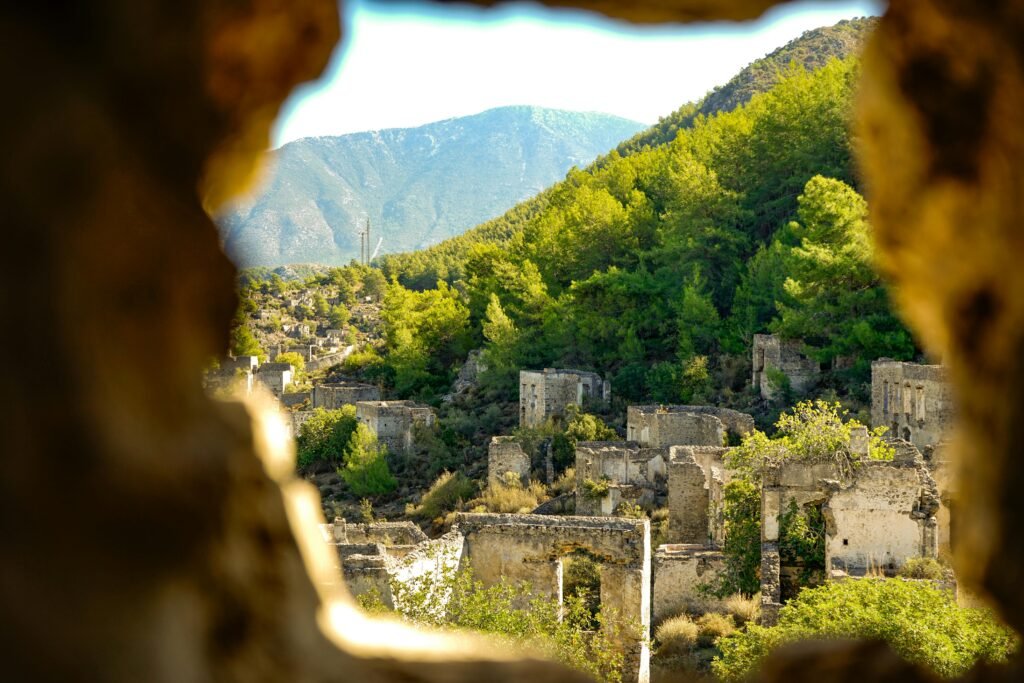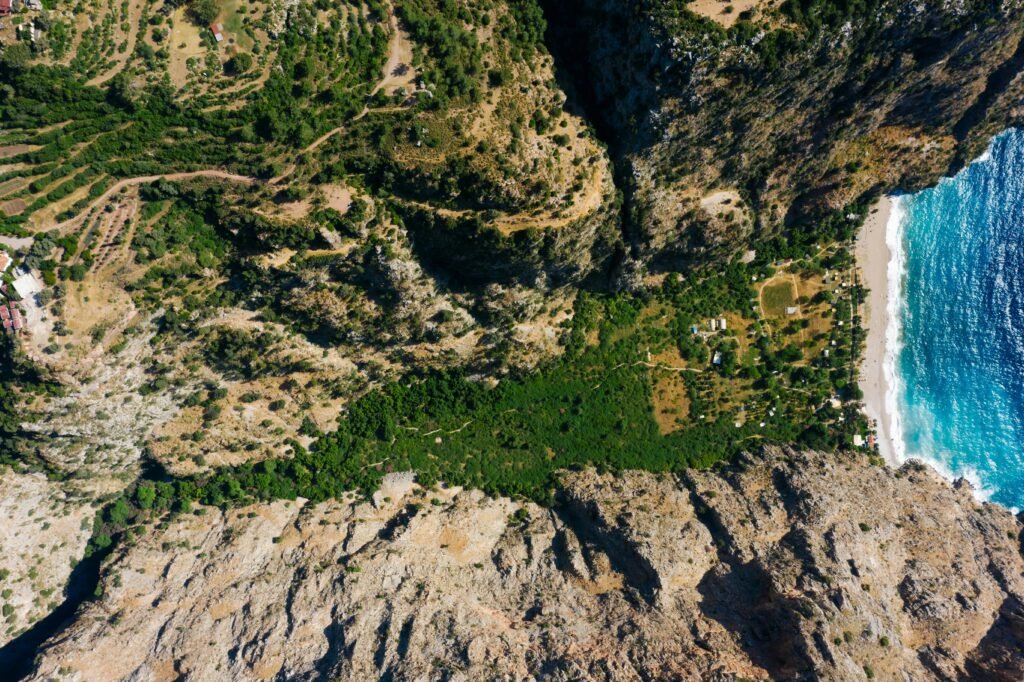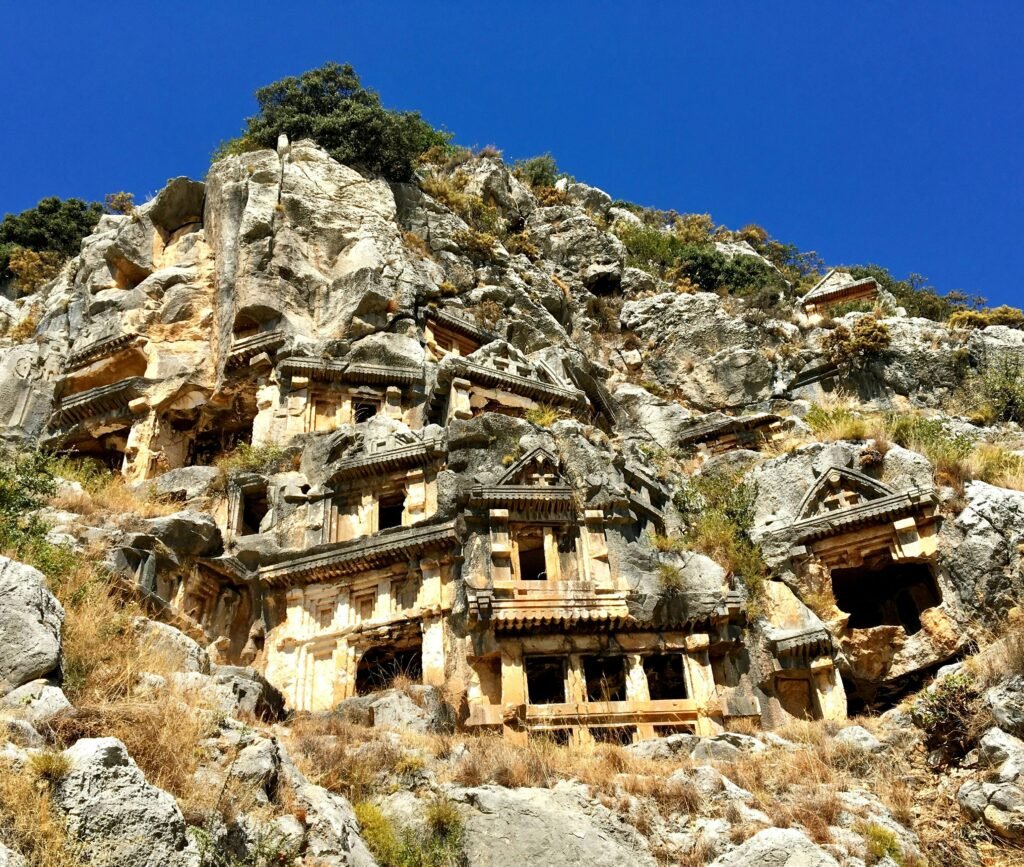Introduction to the Lycian Way
The Lycian Way, celebrated as one of the world’s most alluring long-distance trekking routes, stretches approximately 540 kilometers along the southwestern coast of Turkey. This remarkable trail traces the footprint of the ancient Lycian civilization, which thrived in this region over two millennia ago. Rich in history and natural beauty, the Lycian Way presents an exceptional opportunity for trekkers to immerse themselves in both the stunning landscapes and the remnants of a bygone era.

Embarking on the Lycian Way allows adventurers to traverse through a diverse array of terrains, from rocky cliffs to serene coastal paths. The trail showcases the exquisite Mediterranean coastline, providing breathtaking views of turquoise waters that glitter under the sun. The path takes trekkers through charming traditional villages and ancient ruins, encapsulating the essence of the former Lycian lands, which were known for their unique rock-cut tombs, amphitheaters, and vibrant settlements.
The origins of the Lycian Way date back to 2000 BC, as it was initially used by the Lycians for trade and communication. With its revival as a trekking route in the early 2000s, it has gained international recognition, earning its place in the hearts of hiking enthusiasts from around the globe. Hikers are drawn to the trail not only for its picturesque views but also for the rich cultural narratives embedded within its landscapes.
This trekking route typically takes about 30 days to complete, enabling trekkers to experience the charm of charming coastal towns such as Fethiye, Olympos, and Kas. As they explore, trekkers gain insights into the historical significance of the region while enjoying the diverse flora and fauna, making the Lycian Way a true paradise for those who seek adventure in nature’s embrace.
The Historical Significance of the Lycian Way
The Lycian Way, stretching along the southwestern coast of Turkey, is not only a stunning trekking route but also a pathway steeped in rich history and cultural significance. The trail traverses the ancient region of Lycia, known for its distinctive rock-cut tombs, impressive amphitheaters, and ruins of cities that date back to as early as the 5th century BC. These archaeological remains serve as a testament to the rich heritage of the Lycian civilization, which flourished in this region during ancient times.
As trekkers navigate through the picturesque landscapes of the Lycian Way, they encounter a variety of ancient sites that offer fascinating glimpses into Lycian life. Cities such as Xanthos and Patara were once vibrant urban centers, and remnants of their grandeur still echo through the ruins that dot the trail. Xanthos, in particular, has been recognized as a UNESCO World Heritage site, celebrated for its monumental tombs and inscriptions that render insight into the social and political structures of ancient Lycia.
The significance of the Lycian Way extends beyond its breathtaking vistas; it encapsulates a blend of various cultural influences, including those from the Greeks, Romans, and Byzantines, who all left indelible marks on this region. The rock-cut tombs, which are characteristic of Lycia, reveal the unique funerary practices of the Lycian people, emphasizing their beliefs in the afterlife and ancestral veneration. Moreover, the numerous ancient theaters found along the trail highlight the region’s historical importance as a cultural hub, fostering the arts and community gatherings.
In summary, the Lycian Way is more than a mere hiking trail; it is a journey through time, providing trekkers with a profound appreciation for the ancient civilization of Lycia. The wealth of archaeological sites encountered along the route underscores the crucial role that this region played in the historical tapestry of Anatolia, enriching the cultural heritage of Turkey as a whole.

Key Sections of the Route: An Overview
The Lycian Way, one of the most breathtaking trekking routes in the world, extends approximately 540 kilometers along the southwestern coast of Turkey. Starting in the picturesque town of Fethiye, trekkers embark on a journey that is as diverse in landscapes as it is rich in history. Fethiye serves as a gateway to the route, providing access to stunning coastlines, ancient ruins, and panoramic views. The initial section from Fethiye to Ölüdeniz is particularly notable, as it encompasses crystal-clear waters and the iconic Blue Lagoon, a popular destination for both hikers and beachgoers.
As the trail continues, it leads to Ölüdeniz, renowned for its stunning beach and azure sea. Here, the Lycian Way ventures through charming villages and lush landscapes, offering trekkers glimpses of Lycian rock tombs that reflect the area’s historical significance. The path then progresses towards Patara, famous for its expansive beach and ruins that date back to antiquity. Patara is a prominent historical site, offering visitors a combination of natural beauty and archaeological wealth, further enriching the trekking experience.
The route eventually ascends towards the magnificent Mount Olympos, where hikers can revel in the unique spectacle of the everlasting flames of Chimaera. This section of the trail not only offers adventurous ascents but also opportunities to explore the surrounding natural parks and ancient ruins. The transition from lush greenery to the rocky terrain of the mountains highlights the diverse ecosystems that the Lycian Way traverses, making it a paradise for nature enthusiasts and history lovers alike. Trekking through these key sections lays the groundwork for a more detailed examination of each destination, showcasing the unique characteristics that make the Lycian Way an exceptional adventure.
Fethiye: The Gateway to Adventure
Fethiye, situated on the southwestern coast of Turkey, serves as a stunning gateway to the renowned Lycian Way. This picturesque town is characterized by its vibrant harbor, where a blend of traditional gulets and modern yachts bob in the turquoise waters. The harbor area is bustling with life and offers visitors a plethora of options for dining and leisure activities, making it a perfect starting point for any adventure seeker.
Upon exploring Fethiye, visitors can immerse themselves in local culture by strolling through the lively markets. The market showcases an array of fresh produce, spices, and artisan crafts that reflect the rich history and traditions of the region. Engaging with local vendors provides insights into daily life in this coastal town, further enhancing the adventurer’s experience before embarking on the trekking routes of the Lycian Way.
Fethiye is also home to several historical landmarks, including the impressive rock tombs of Amyntas, which date back to the 4th century BC. These ancient tombs, carved into the cliffs, serve as a firm reminder of the Lycian civilization’s storied past. Their strategic location offers not only a glimpse into history but also breathtaking views of the surrounding landscape, which are particularly captivating at sunrise and sunset.
For trekkers, Fethiye boasts multiple routes leading into the enchanting paths of the Lycian Way. These trails cater to varying skill levels, offering something for both novice and experienced walkers. Wildflowers, ancient ruins, and sandy beaches punctuate the landscape, providing ample opportunities for exploration and relaxation. Additionally, nearby attractions such as the stunning bays, including Ölüdeniz, entice trekkers to take detours and relish the natural beauty inherent in the region. The scenic allure and cultural richness of Fethiye indeed make it a prime starting point for adventures along the Lycian Way.
Ölüdeniz: A Coastal Gem
Ölüdeniz, a picturesque village on the southwestern coast of Turkey, is renowned for its stunning blue lagoon, which has garnered international acclaim. This idyllic destination boasts crystal-clear turquoise waters that blend seamlessly with pristine sandy beaches, making it a favored spot for both relaxation and adventure. Nestled at the foot of the majestic Babadağ mountain range, Ölüdeniz offers a breathtaking backdrop that enhances its natural beauty, creating a serene environment perfect for trekkers and nature enthusiasts.
The area’s beaches, particularly the famous Ölüdeniz Beach, are ideal for sunbathing and swimming. However, for those seeking adventure, Ä°kizler Beach and Kayaköy nearby offer unique opportunities for exploration and trekking. The surrounding terrain is crisscrossed with scenic trails, leading to captivating views of the coastline and the lush landscapes of the region. As trekkers navigate these paths, they can encounter diverse flora and fauna, enriching their hiking experience.
Ölüdeniz is not only about land adventures; it also presents thrilling opportunities for paragliding. The heights of Babadağ provide an unparalleled launch point, where adventurers can soar above the azure waters and witness the iconic views that Ölüdeniz is famous for. This activity attracts many visitors who wish to experience the breathtaking coastal vistas from a bird’s-eye perspective, and it complements the hiking opportunities available in the area.
The combination of beautiful beaches, picturesque mountain ranges, and various recreational activities makes Ölüdeniz a must-visit destination for trekkers and travelers alike. Whether one seeks the tranquility of the lagoon or the thrill of adventure sports, Ölüdeniz undoubtedly caters to diverse preferences, solidifying its status as a coastal gem on the Lycian Way.

Patara: Beaches and Ruins
Patara is a remarkable destination along the Lycian Way, renowned for its stunning blend of natural beauty and historical significance. The region boasts one of the longest sandy beaches in Turkey, offering crystal-clear waters and a tranquil atmosphere that attracts both local and international visitors. This pristine beach is not only a paradise for sunbathers and swimmers but also serves as a nesting ground for the endangered loggerhead sea turtles, making it vital to preserve the integrity of the area.
In addition to its captivating coastline, Patara is steeped in history. The ancient city of Patara was once a significant port and a thriving cultural hub of the Lycian civilization. Among the ruins, the well-preserved amphitheater stands out, highlighting the architectural prowess of the time. This ancient site, capable of seating thousands, is a testament to the rich history and cultural life that thrived in this region. Visitors can wander through the remnants of temples, baths, and agora, which collectively narrate the story of Patara’s illustrious past.
Adjacent to the beach is the Patara National Park, an area that plays a crucial role in the conservation of both its wildlife and historical artifacts. Established to protect the unique ecosystem and archaeological treasures, the park ensures that future generations can enjoy and learn from Patara’s natural and historical wonders. The juxtaposition of the beach and the ruins exemplifies the importance of sustainable tourism, encouraging visitors to appreciate and protect this invaluable heritage.
As part of the Lycian Way, Patara not only enriches the trekking experience but also emphasizes the significance of preserving such areas for their ecological and cultural value. The combination of breathtaking landscapes and ancient history positions Patara as a pivotal stop for those exploring the wonders of the Lycian Way.
Mount Olympos: Nature Meets Mythology
Mount Olympos, renowned for its striking natural beauty and rich mythological heritage, is a remarkable destination for trekkers seeking an immersive experience in the heart of nature and history. This majestic mountain, part of the Taurus Mountain range in southwestern Turkey, has long been revered as a significant site in Greek mythology, being associated with the home of the ancient gods. Hiking routes leading up to Mount Olympos offer avid adventurers a unique opportunity to explore diverse landscapes, from lush forests and rocky outcrops to breathtaking vistas overlooking the Mediterranean Sea.
The ascent to Mount Olympos is not just a physical journey; it is also a journey through time, where one can encounter remnants of ancient civilizations sprinkled along the trails. The most commonly traveled path is part of the renowned Lycian Way, a long-distance trail that covers approximately 540 kilometers, showcasing the cultural richness and natural splendor of the Lycia region. Hikers may traverse through fragrant pine forests, gaze upon glittering streams, and witness a variety of endemic flora and fauna, providing a natural backdrop that enhances the hiking experience.

Practical Tips for Hikers
The Lycian Way is a captivating trekking route that offers unparalleled views of the rugged coastline, ancient ruins, and diverse ecosystems. To make the most of your hiking experience, consider the following practical tips.
The best seasons for trekking the Lycian Way are spring (April to June) and autumn (September to October), when temperatures are milder, averaging between 15°C to 25°C (59°F to 77°F). Summer months can be exceedingly hot, making it challenging for hikers to enjoy the trek while also risking dehydration and heat exhaustion. If you decide to hike during peak summer, start early in the morning and bring plenty of water.
When it comes to accommodation, hikers have various options. Guesthouses and hostels are plentiful in nearby villages such as Olympos and Kas, providing a comfortable resting place after a long day on the trail. Additionally, for the more adventurous, camping along the route is allowed in designated areas. This option allows trekkers to immerse themselves in nature and enjoy the stunning sunset over the Mediterranean Sea.
Selecting the right gear is essential for a successful trek. Quality hiking boots with good ankle support are crucial, as the terrain can be uneven with rocky paths. A lightweight backpack will help you carry the necessary items without overburdening yourself. Make sure to pack a first-aid kit, sunscreen, a refillable water bottle, and snacks to keep your energy levels up throughout the day. It can also be invaluable to have a map or a GPS device, ensuring you stay on the right path.
Your experience can be enriched by interacting with locals along the way. They can provide valuable insights into the history and culture of the region, as well as suggest hidden gems that are off the beaten path. Embracing these local experiences not only enhances your trek but also fosters a deeper connection to the destination.
Cultural Experiences Along the Trail
The Lycian Way is not just a well-trodden path; it is a gateway to experiencing the rich cultural tapestry of Turkey’s southwestern coastline. Trekkers along this magnificent route can immerse themselves in the vibrant local culture that adds depth to the natural beauty of the region. One of the most significant aspects of the trail experience is the opportunity to savor authentic Turkish cuisine, renowned for its bold flavors and diverse ingredients. Local dishes such as meze, a variety of small plates, and gözleme, a traditional stuffed flatbread, showcase the culinary heritage of the Lycians. Each village along the trail offers its take on these dishes, allowing trekkers to indulge in a delightful exploration of taste.
The warm hospitality of the local people enhances the trekking experience significantly. Villagers often welcome trekkers into their homes, offering refreshing drinks and home-cooked meals that reflect their generous spirits. This interaction fosters a sense of community and connection that transcends cultural barriers. Trekkers can participate in local customs, such as traditional music and dance or even helping with daily activities like farming or artisanal crafts. This direct engagement provides profound insights into the local way of life, transforming a mere hike into an enriching cultural exchange.
Moreover, various festivals and events celebrated along the trail present further opportunities for engagement. For instance, local harvest festivals are marked by vibrant markets and cultural performances, allowing trekkers to witness the vibrancy of the community firsthand. Each encounter along the Lycian Way leaves a lasting impression, making the journey not just a trek through nature but a passage through the heart of Turkish culture. By prioritizing these immersive cultural experiences, trekkers gain a multifaceted understanding of the region that elevates their adventure beyond the physical realm.
Conclusion: The Lycian Way Awaits
The Lycian Way stands as a beacon for adventure travelers seeking an extraordinary trekking experience. Nestled along the southwestern coast of Turkey, this remarkable trail offers a unique blend of natural beauty, cultural heritage, and personal transformation. With its diverse landscapes ranging from rugged mountains to serene coastal paths, trekkers are treated to some of the most breathtaking views in the world.
One of the most compelling reasons to embark on this journey is the rich history that permeates the Lycian Way. As you walk, you will encounter ancient ruins that narrate the tales of civilizations past, from the Lycian tombs carved into rock faces to the remnants of old amphitheaters. These historical landmarks not only enrich your understanding of the region’s cultural heritage but also provide a tangible connection to the past, enhancing the overall trekking experience.
Moreover, the opportunity for cultural interactions along the trail adds another layer to the adventure. As you traverse through charming villages, you are likely to meet welcoming locals eager to share their traditional lifestyles. Sampling local cuisine, engaging in meaningful conversations, and participating in age-old customs can transform a simple trek into a memorable exchange of values and stories, creating lasting connections.
Beyond the physical challenge, hiking the Lycian Way is often described as a transformative journey. The act of walking amidst nature can be profoundly meditative, allowing trekkers to reflect and rejuvenate. The sense of achievement from completing such a trek is invigorating, igniting a sense of adventure that can inspire further exploration.
Ultimately, the Lycian Way is not just a trail; it is a holistic experience that caters to the adventurous spirit in all of us. For those who seek to immerse themselves in a symphony of stunning landscapes, rich history, and vibrant culture, this remarkable trail awaits your footsteps.
